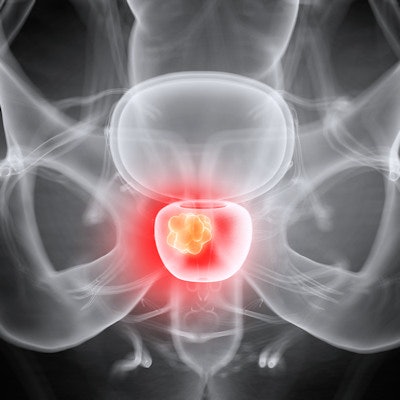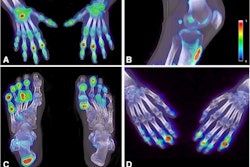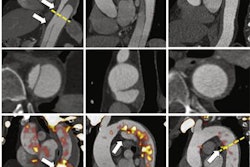
Sodium fluoride (NaF) PET/CT rarely adds value for detecting bone metastases in patients with intermediate- and high-risk prostate cancer and normal bone scintigraphy results prior to prostatectomy, according to a study published online May 30 in the Journal of Nuclear Medicine.
In a prospective study, Danish researchers found that only one patient among 81 subjects had a bone metastasis that was missed on a bone scintigraphy exam but detected on NaF-PET/CT. The modality also had no effect in predicting long-term patient outcomes, as it didn't discover any previously unseen bone metastases in patients who didn't respond to treatment.
"The key findings, based on the concept of including NaF-PET/CT findings in addition to negative bone scintigraphy findings, showed that NaF-PET/CT did not show bone metastases in any patients with biochemical failure," wrote the researchers led by Dr. Helle Zacho, PhD, from the Clinical Cancer Research Center at Aalborg University Hospital. "This observation was correct in the present population because no bone metastases were detected after 24 months of follow-up."
Previous research suggested that NaF-PET/CT can significantly improve the detection of bone metastases in prostate cancer patients, with estimates that the modality can change treatment plans in as many as 12% of cases when performed for initial staging. However, Zacho and colleagues wrote that "it remains to be shown whether the increased diagnostic performance afforded by NaF-PET/CT correctly changes patient management and improves patient outcomes."
Therefore, they set out to explore NaF-PET/CT's efficacy by prospectively enrolling 81 consecutive patients (mean, 65 years; range, 47-77 years) with newly diagnosed, intermediate- and high-risk prostate cancer and with no indication of bone metastases on standard bone scintigraphy. Two physicians evaluated the NaF-PET/CT results with no knowledge of patients' clinical information or bone scintigraphy findings.
Their consensus review found no evidence of bone metastases among 73 prostate cancer patients (90.1%). Conversely, NaF-PET/CT revealed a bone metastasis in only one patient (1.2%) that was missed on scintigraphy. The researchers noted equivocal findings in the remaining seven patients (8.6%).
Interestingly, all eight of those patients achieved a biochemical response to treatment, while the six patients who did not respond to radical prostatectomy had a negative NaF-PET/CT result or bone scintigraphy that indicated metastases.
In all, 75 patients (93%) achieved a biochemical response to treatment at the six-month follow-up, as confirmed by a prostate-specific antigen (PSA) level of less than 0.2 ng/mL. At 24 months after radical prostatectomy, no bone metastases were found in the one patient who showed a metastasis on initial NaF-PET/CT or in the seven patients who had equivocal results on the modality.
"The strength of the present study lies in the prospective design including a homogeneous and representative group of newly diagnosed prostate cancer patients eligible for radical prostatectomy," the researchers added. "The present study had a true reference standard for the absence of bone metastases at the time of staging based on postoperative PSA levels, whereas the majority of [previous] studies on NaF-PET/CT either focused on the detection rate without a proper reference or focused on the validation of bone metastases and not on the verification of a lack of bone metastases."




















